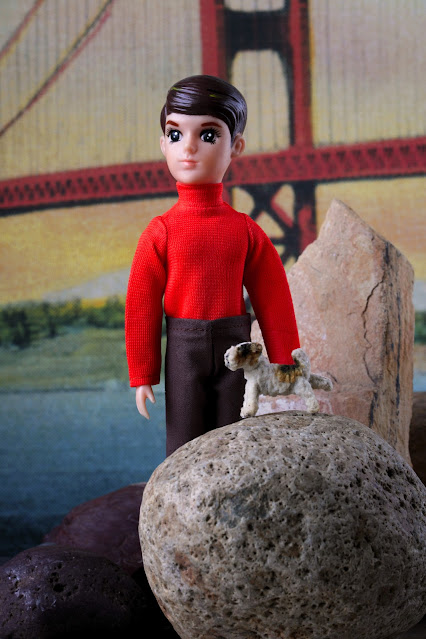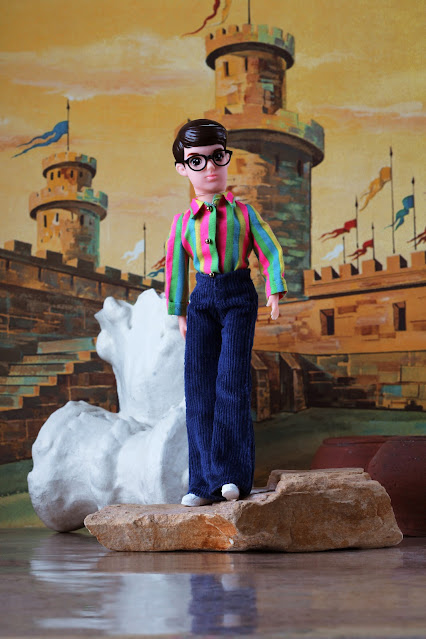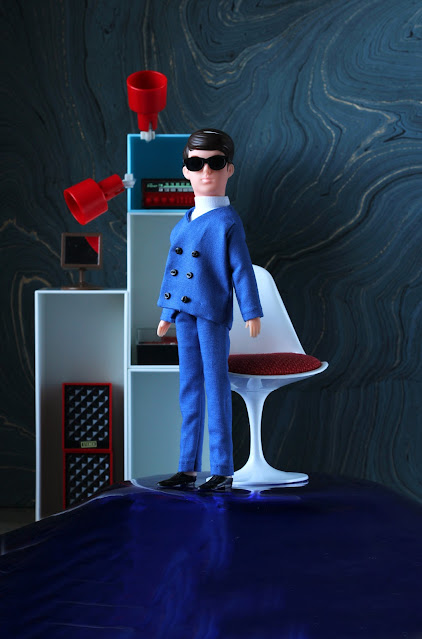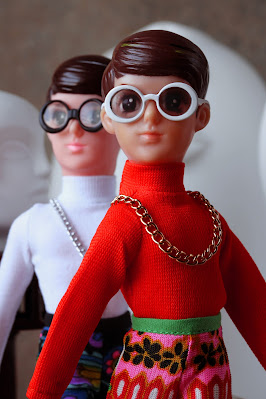Introduced in 1968 to the Japanese market by toymaker Takara as the boyfriend of their Licca-chan doll, Wataru Tachibana was meant to be, not unlike the Barbie doll's Ken Carson by Mattel, a steady presence supporting the star of the show, Licca Kayama, who along with girlfriend Izumi Satō composed a lively doll trinity for Japanese kids who already enjoyed the powerful esthetic influence of manga and animé.



 Wataru-kun brought a romanticized concept of boyhood to the mix, existing to play the guitar (as per the Licca-chan Trio television commercial), be at the top of his 6th grade class, be good at all sports, and wear the coolest late 60s duds.
Wataru-kun brought a romanticized concept of boyhood to the mix, existing to play the guitar (as per the Licca-chan Trio television commercial), be at the top of his 6th grade class, be good at all sports, and wear the coolest late 60s duds.
Turtleneck by Atelier Milabrocc and slacks by Fille de Rêve.

 Now, if the eyes are the window to the soul, it's not a stretch to say that that is how Wataru sealed the deal. For when the image of a character is created, one thinks that considerable thought must be given to the impact of the gaze. In the case of Takara's vintage and reproduction Wataru-kun doll, one can conjecture that the style of shōjo manga artist Miyako Maki, who was engaged by Takara to illustrate the face of what would become the Licca-chan doll, is also the defining force behind the countenance of the remarkable 12-year-old Wataru Tachibana: expressive eyes surrounded by lush eyelashes and framed by caterpillar eyebrows, an Edwardian-style haircut, and closed-mouth that gives the Mona Lisa a run for her money given the utter ambiguity of its expression.
Now, if the eyes are the window to the soul, it's not a stretch to say that that is how Wataru sealed the deal. For when the image of a character is created, one thinks that considerable thought must be given to the impact of the gaze. In the case of Takara's vintage and reproduction Wataru-kun doll, one can conjecture that the style of shōjo manga artist Miyako Maki, who was engaged by Takara to illustrate the face of what would become the Licca-chan doll, is also the defining force behind the countenance of the remarkable 12-year-old Wataru Tachibana: expressive eyes surrounded by lush eyelashes and framed by caterpillar eyebrows, an Edwardian-style haircut, and closed-mouth that gives the Mona Lisa a run for her money given the utter ambiguity of its expression.

Today, it is not uncommon to find differences in vintage iterations of Wataru-kun dolls, most notably the color of the vinyl that, not unlike Barbie doll's TNT period, can sometimes fade. Wataru-kun's hair color ranges from a dark reddish-brown to umber, always with similar but not exactly located highlights ranging from off-white to light muted yellow and lowlights in black. Eyebrow shapes also vary as well as the intensity of application of cheek blush. Lip colors range from pink to cream and the latter is commonly assumed to be fading of the paint just like it happens on Barbie dolls from 1964-1965. These variations enhance the complexity of collecting vintage Wataru-kun dolls.


So, what is Wataru-kun to wear? In addition to a richly diverse offering of separate boxed fashions (very hard to find today), Wataru-kun is amenable to wearing clothing created for 9" dolls such as Mattel's Skipper and Ricky, Hasbro's Wonderful World of Love, Azone Pure Neemo XS, and whatever indie designers create for Blythe, 4th generation Licca, or for him exclusively. Shoes are another matter, as the foot sculpt is as specific as his elegantly pointed lace-up shoe style created of pliable vinyl in black, brown, and white, yet vintage Barbie tennis shoes, Francie ankle boots, and Fashionistas' sneakers are possible options that work in scale and fit.
Wataru-kun was offered until 1972 and returned by the end of the 20th century as part of a three-doll commemorative set, an event that coincided with the height of Blythe doll's renaissance, also produced by Takara. Blythe doll expert and designer of the phenomenally joyful Endangered Sissy line, Pamela, recounts: "There's long been a cross-over between the Licca-chan and Blythe worlds. The first Neo Blythe dolls were on Licca-chan bodies and of course they were both manufactured by Takara. Awareness of Wataru-kun really hit Blythe collectors when Takara started releasing reproduction sets of the 1st generation Licca Trio. That was when I first saw him, and immediately knew I needed him in my collection. His face is so perfectly kawaii, with the big eyes and long painted lashes, and he fits in so well with the Blythe retro style aesthetic I love so much. Another bonus for Blythe collectors is that they have the same size body and can share all their clothes."
A visit to Flickr (yes, it's still alive and thriving) yields an enormous harvest of photos, mostly from the early 2010s of Wataru-kun dolls, both vintage and reproduction, wearing what fits, regardless of gender coding, and enjoying life as an independent character.
For this Dolldom exclusive, vintage and reproduction Wataru-kun dolls enjoy a revisit to the late 60s and early 70s in both vintage as well as new garments styled to pay homage to his original style as well as to expand on themes, had he been produced after 1972. Dolldom wishes to thank Endangered Sissy and Cindy's Barbie Boutique for their willingness to collaborate in the creation of fab couture for the young Tachibana.


Cindy's Barbie Boutique slacks and a vintage top from Ricky doll's skateboarding set by Mattel. Hat by Premier. Glass frames by Integrity Toys.

Wataru-kun was offered until 1972 and returned by the end of the 20th century as part of a three-doll commemorative set, an event that coincided with the height of Blythe doll's renaissance, also produced by Takara. Blythe doll expert and designer of the phenomenally joyful Endangered Sissy line, Pamela, recounts: "There's long been a cross-over between the Licca-chan and Blythe worlds. The first Neo Blythe dolls were on Licca-chan bodies and of course they were both manufactured by Takara. Awareness of Wataru-kun really hit Blythe collectors when Takara started releasing reproduction sets of the 1st generation Licca Trio. That was when I first saw him, and immediately knew I needed him in my collection. His face is so perfectly kawaii, with the big eyes and long painted lashes, and he fits in so well with the Blythe retro style aesthetic I love so much. Another bonus for Blythe collectors is that they have the same size body and can share all their clothes."
A visit to Flickr (yes, it's still alive and thriving) yields an enormous harvest of photos, mostly from the early 2010s of Wataru-kun dolls, both vintage and reproduction, wearing what fits, regardless of gender coding, and enjoying life as an independent character.
For this Dolldom exclusive, vintage and reproduction Wataru-kun dolls enjoy a revisit to the late 60s and early 70s in both vintage as well as new garments styled to pay homage to his original style as well as to expand on themes, had he been produced after 1972. Dolldom wishes to thank Endangered Sissy and Cindy's Barbie Boutique for their willingness to collaborate in the creation of fab couture for the young Tachibana.


Cindy's Barbie Boutique slacks and a vintage top from Ricky doll's skateboarding set by Mattel. Hat by Premier. Glass frames by Integrity Toys.

Mod top by Endangered Sissy. Slacks by Cindy's Barbie Boutique.
 Reproduction Wataru-kun in a vintage Takara shirt and slacks by Cindy's Barbie Boutique. Fashionista Barbie tennis shoes.
Reproduction Wataru-kun in a vintage Takara shirt and slacks by Cindy's Barbie Boutique. Fashionista Barbie tennis shoes.
 Wataru wears a suit made by Cindy's Barbie Boutique and a vintage orange turtleneck from World of Love by Hasbro.
Wataru wears a suit made by Cindy's Barbie Boutique and a vintage orange turtleneck from World of Love by Hasbro.

Vintage Takara tuxedo jacket over an Atelier Milabrocc turtleneck and slacks by Cindy's Barbie Boutique. Glasses by Dragons in Dreams.


In vintage Ricky's bathrobe and Skooter's swimsuit bottoms, a vintage Wataru-kun shelters from the sun in a Waka Murai hat borrowed from Julian Kalinowski's Lilli Lalka.
 Vintage Wataru-kun in a yukata by Azone Pure Neemo XS.
Vintage Wataru-kun in a yukata by Azone Pure Neemo XS.  Vintage Wataru-kun in a vintage Takara shirt and slacks onesie and a Cindy's Barbie Boutique blue jacket.
Vintage Wataru-kun in a vintage Takara shirt and slacks onesie and a Cindy's Barbie Boutique blue jacket. Reproduction Wataru-kun in vintage Skipper's shirt and bell bottom corduroy slacks by Ababietoy on Etsy. Frames by Takara.
Reproduction Wataru-kun in vintage Skipper's shirt and bell bottom corduroy slacks by Ababietoy on Etsy. Frames by Takara. Super agent Wataru-kun in turtleneck by Atelier Milabrocc, blue suit by Cindy's Barbie Boutique, and a trench by Takara for 4th generation Licca-chan.
 Awards ceremonies call for a vintage tuxedo by Takara. Glasses by Takara.
Awards ceremonies call for a vintage tuxedo by Takara. Glasses by Takara. A velvet suit by Cindy's Barbie Boutique is perfect for playing bartender.
A velvet suit by Cindy's Barbie Boutique is perfect for playing bartender.  Vintage Wataru-kun in a turtleneck by World of Love. Bell bottom corduroy slacks by Fille de Rêve on Esty. Sunglasses by Takara. 1962 Corvette by Bratz doll.
Vintage Wataru-kun in a turtleneck by World of Love. Bell bottom corduroy slacks by Fille de Rêve on Esty. Sunglasses by Takara. 1962 Corvette by Bratz doll. Vintage Wataru-kun and Izumi-chan in vintage fashions by Takara.
Vintage Wataru-kun and Izumi-chan in vintage fashions by Takara.  Vintage Goro-chan plays with a vintage Wataru-kun in shirt and pants by M for Monkey.
Vintage Goro-chan plays with a vintage Wataru-kun in shirt and pants by M for Monkey.  Vintage Wataru-kun and Licca-chan dolls in vintage fashions by Takara.
Vintage Wataru-kun and Licca-chan dolls in vintage fashions by Takara. Resources for readers:




















